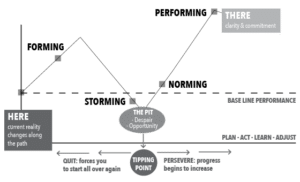We know that the Project Mood Curve is the trajectory of any project or task that we will undertake. But what if it is also the structure of the story of our lives as a whole?
Plot Structure
You probably learned the structure of a plot in your grade school English class. The story starts with some Exposition before introducing the Conflict. Then most of the story will be the Rising Action that all leads to the Climax, or the place where the Conflict is confronted. Next is the Falling Action which deals with the fallout of the Climax. And the story ends with the Resolution in which the Conflict does not have to be solved, but it is at least wrapped up for now.
In the Christian world, I have heard of another paradigm for looking at story structure: Creation – Fall – Redemption – Restoration
Creation – Fall – Redemption – Restoration
It’s the story of the Bible, but, if you start to look for it, it’s also the structure for every (good) story and of our lives.
Creation: God said “let there be light” and he found everything He made good, except for mankind, who He said was “very good.”
Fall: The serpent tempted Eve and she gave in and ate of the tree of the knowledge of good and evil, and she invited her husband Adam to eat of it too. They both felt ashamed of their newly found nakedness and attempted to hide from God.
Because of their sin, God placed a curse on the earth and mankind now has to live with the consequences of their actions.
Redemption: When Jesus died on the cross, He took on Himself the punishment that was owed to us for the wrongs we have done in sinning. And when He came back to life three days later, an event we just celebrated earlier this month on Easter, He brought us new life that we might live with Him in Heaven forever.
But even before we get to experience the fullness of that redemption when we will see His face, we still experience acts of redemption daily, with Jesus constantly granting us forgiveness for the ways we have strayed and guiding us back to Himself.
Restoration: One day Jesus will come again and usher in a new heaven and a new earth and restore all things to their former glory as they were in Creation. This is not restoration on an individual level but on a corporate level; on a level that includes all of creation. There will not just be spiritual restoration, but physical restoration as well.
Knowing that this day of full restoration is coming, we can live with expectant hope and strive to act with this eternal goal in mind, not just focused on our day-to-day efforts.
This is clearly seen in the overarching story of the Bible, but the structure can also be found in many other plots and stories, including the story of our lives.
Let’s compare it to the typical plot structure you learned in English class. The Exposition would be Creation. We establish the status quo and there is a sense of relative peace in this pre-disrupted world. The Conflict is the Fall. Something bad happens that changes the trajectory of the story and all the characters have to live based on this new reality. The Rising Action leads to the Climax which is Redemption. We confront the Fall and deal with it once and for all, ending with the Resolution or Restoration. At the end of the story, things don’t go back to the way they were at the beginning. The characters have had new experiences that have changed them. In the Restoration, we don’t go back to the way things were. We move forward into a new life in which the peace of Creation is restored, but it’s within our new redeemed context.
So we see how these two paradigmswork together in stories, but how do they relate to our lives?
The Project Mood Curve

The Project Mood Curve begins whenever you decide to start a new project or task.
Forming: You start here in the Forming stage when you set out your expectations for this new project. Things will likely go well at the beginning as you’re getting everything together, but this honeymoon phase can’t last forever.
Storming: We also refer to this stage as the Pit of Despair. This is a place of reckoning where you must decide if you’re going to forge on or restart with a new project. Sometimes you restart because you give up on a good project, and sometimes in the Storming phase you realize that your project does not help you pursue your There, so you quit it to begin again with something aimed at your There.
Norming: If you make it out of the Storming phase and continue with the project, you enter into the Norming stage where you take what you learned from the Pit of Despair and resolve any conflict or roadblocks you hit while Storming.
Finally we reach the Performing stage where we exceed the expectations set in the Forming stage and are able to complete the project with all the knowledge gained in the phases along the way. Unfortunately, the Performing stage does not last forever, and we will circle back to the Forming phase when we advance to the next stage in the project.
Now there are four phases to the Project Mood Curve, which can each correspond to a stage of Creation – Fall – Redemption – Restoration.
The Forming stage is Creation where everything is good and we set out expectations for how everything should go. But then the Storming stage, or the Fall, makes those original expectations harder or impossible to meet. The hope of the gospel, though, is that we don’t stay in the Fall forever, just as we don’t remain in the Pit of Despair. God reaches us even in our brokenness and brings us into His Redemption, which corresponds to the Norming stage. The trials in the Storming phase weren’t all for waste because now you are better prepared for what lies ahead. Finally we enter the Performing stage in which we have the Restoration of our former hopes and expectations, manifested in ways we wouldn’t have expected.
The Story of Life
We often talk at the Crossroad about how having a There or seeing a vision of something to work towards outside yourself helps you have agency and work with purpose. But I want you to see today that you are also part of a much larger story of life. You participate in the narrative of Creation – Fall – Redemption – Restoration every day, both in the overarching narrative of your life and in the little cycles we go through every day as we walk along the Project Mood Curve. This should bring you hope and fill you with purpose as you walk out the Goals and Milestones that you have set for yourself.
Gracie McBride is the Content and Systems Management Coordinator for The Crossroad.





